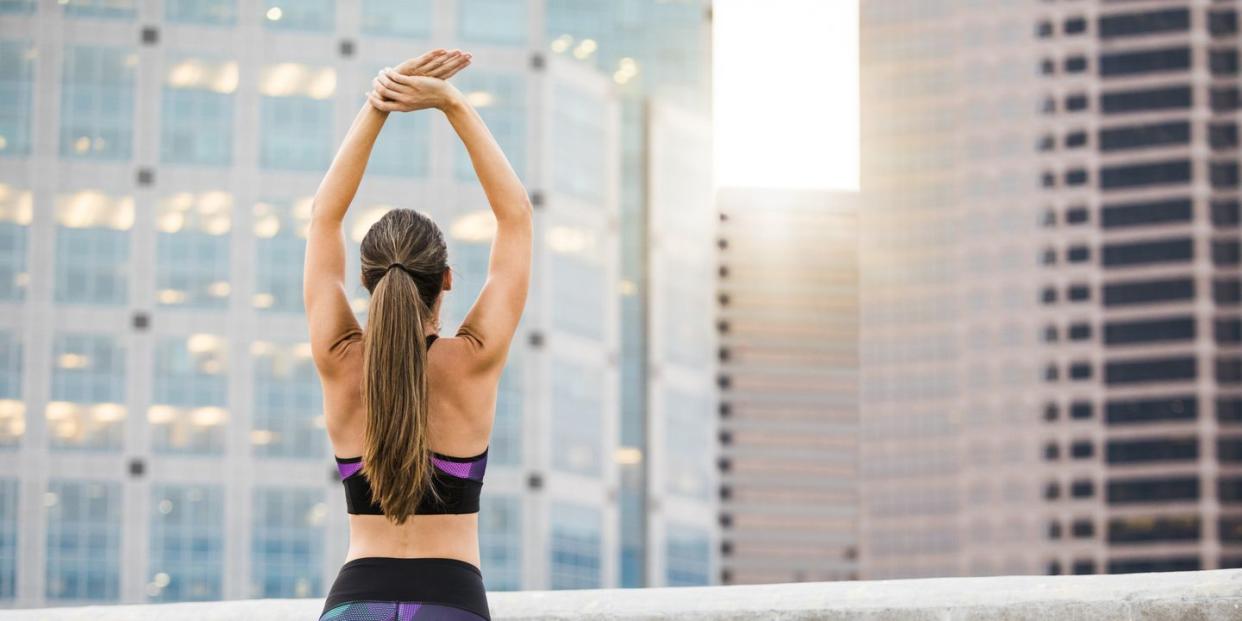Exactly How To Get Rid Of Those Bumps On The Back Of Your Arms

Nothing can kill your summertime sleeveless vibes quite like the red bumpy skin on the back of your arms. If you're like 40 percent of the adult population, those bumps are probably the result of keratosis pilaris, or KP as it's more commonly known.
But while body scrub or your go-to lotion may help with plain old dry skin, reaching for them won't do the trick to get rid of your KP. These hard-to-treat bumps require a totally different regimen. Consider this your keratosis pilaris treatment plan.
First, what exactly is keratosis pilaris?
"Keratosis pilaris is a common, yet harmless, skin condition that presents as tiny white or red bumps on top of dry, rough skin," says Sunheel Chilukuri, MD, dermatologist and director of cosmetic surgery at Refresh Dermatology in Houston, TX.
Those bumps form when your skin overproduces keratin (an important building-block protein in your bod). The buildup of keratin then plugs up your hair follicles, causing tough little bumps that can look red and rough, which is where the skin condition got its nickname, chicken skin. "The rough skin and bumps may sometimes itch," adds Dr. Chilukuri.
What can cause KP?
The bad news: Keratosis pilaris can't be totally cured or prevented (sorry!). It's genetic, so go ahead and blame your parents. "KP is inherited in an autosomal dominant fashion," explains Dr. Chilukuri, "Meaning, if one of your parents has this condition, there is a 50 percent chance you will have it."
But the good news: You're not alone. More than three million people in the United States are diagnosed with KP each year. Plus, there are things you can do to help improve the appearance (more on that below).
What should I look out for?
If you're already dealing with those annoying bumps, there are some factors that could be making matters worse. Dry climates, excessive perspiration, or frequent exposure to chlorine (what's up, swimmers?), can exacerbate the condition, according to Dr. Chilukuri.
Also, whatever you do, do not pick at your KP. Although it might be tempting to tear away at those annoying bumps, just like picking a pimple, this is the fastest route to scars and hyperpigmentation.
Where is it most common?
KP most frequently rears its ugly head in places like the upper arms, upper thigh, cheeks, and sometimes even the butt.
"Young children and teenagers may have small red bumps on their cheeks that are often misdiagnosed as acne or rosacea," says Dr. Chilukuri.
What are the best keratosis pilaris treatments?
1. Boost your body wash with a keratolytic agent.
Never heard of keratolytic agents? Here's the deal. They are basically ingredients (including sulfur, lactic acid, urea, and more) that help to break up the stuff that holds the keratin cells together so they can more easily be cleared up.
This bar soap contains a dose a sulfur along with salicylic acid, another keratolytic agent that also has anti-inflammatory powers. Together they can help clear up your KP and any body acne you might have. Bonus!
2. Use a chemical exfoliating lotion.
Moisturizing the dry skin is a crucial step to decreasing the symptoms of KP, but you also need something that will clear up, not further clog, your follicles.
"Anything that gently removes excess cell debris can help smooth the surface and clear follicles," says Dr. Chilukuri, who recommends body creams that contain alpha hydroxy acids (AHAs) or beta hydroxy acids (BHAs).
This lotion from PCA Skin contains 12 percent lactic acid, an AHA derived from fermented milk that gently exfoliates by removing dead skin cells and moisturizes your skin at the same time.
3. Switch to fragrance-free products.
In some cases, keratosis pilaris is exacerbated by wearing fragranced body products like lotions, creams, perfume sprays, soaps, and body washes, and by showering with hot water, says Craig Austin, MD, a dermatologist in NYC.
Make sure your body-care regimen is fragrance-free, and try to use the most lukewarm water possible for showers and baths. Also, keep bath time short (think: under seven minutes) so dehydration of skin is minimized.
4. Try a topical retinoid on your body.
Retinol is a go-to treatment for acne, but Dr. Austin says that the vitamin A derivative’s exfoliating powers also allows fresh skin cells to come up faster, so your chicken skin bumps flatten out.
Just remember that the final result takes patience. You must be on a retinoid for several weeks before you’re in the clear-but once you are, it’s smooth sailing.
If you're not quite ready for a 'scrip retinoid, you can also try an OTC retinol cream (like Differin Gel).
5. Eat plenty of omega-3s
Foods rich in omega-3s are essential for keeping skin moisturized and healthy. These include walnuts, flaxseeds, salmon, tuna, sardines, and soybeans. Leafy greens are also always good to get in for overall skin health and function, says Craig Austin, MD, a New York City dermatologist.
Some foods can make matters worse though: Stay away from dairy products if you’re prone to keratosis pilaris, since it can trigger inflammation (which can in turn trigger conditions like keratosis pilaris), Austin says.
('You Might Also Like',)

